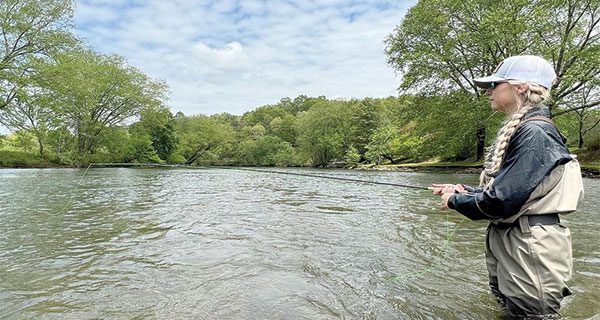Trout seek out specific areas in a stream to feed, hide from predators, and to rest. Anglers can really cut down the time it takes to find them by keeping a few things in mind.
When I approach a new piece of water, I immediately look for trout visibly feeding on or near the surface but also towards the bottom. Amber lenses in a high-quality pair of glasses are as important as your fly reel. If a feeding fish is spotted, the “locating” part is already done.
What if there are no visible signs of fish? How do you find them? Reading the water is an art in itself as much as learning to fly cast well. Feeding trout aren’t everywhere in a stream but in sometimes very tiny spots in a trouty looking area. I usually tell beginning fly fishers to fish where they can’t see the bottom of the river clearly. This could be due to water depth or riffles that give the trout protection from predators. Fishing the green colored water also accomplishes basically the same thing. This is a very broad way of looking for fish because locating that spot within the spot is what separates the folks that catch fish occasionally with the ones that catch fish consistently.
Bubble lines are also good places to look for feeding fish. “Foam is home” is a saying you will hear a lot from guides trying to coax a good drift or give your client a target to toss a fly at. Bubble lines on the surface of the water is just oxygen trapped in the surface tension but is also where ninety percent of what a trout eats on a given day will be found.
Seams where fast water meets slower water is also a good spot to drift a fly. Trout will hold along these areas and slip in and out of the current to retrieve food items. Much like deer or rabbits, trout are creatures of edge. Edge of current, edges of rock to sand, even the drip edge of streamside vegetation can concentrate numbers of fish.
Spots with combinations of more than one of these can be that target area that holds numbers or larger than normal fish. Actively feeding trout will hold in these areas but will spook to the nearest deep water, log, ledge rock or undercut bank at the first sign of danger. Approach these areas carefully with a well-executed cast and you might be rewarded with a sweet hook up.
Give David Hulsey a call at (770) 639-4001 to book a class or a guided trout trip. See his website at www.hulseyflyfishing.com
